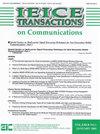Cluster Structure of Online Users Generated from Interaction Between Fake News and Corrections
IF 0.6
4区 计算机科学
Q3 Engineering
引用次数: 0
Abstract
SUMMARY The problem caused by fake news continues to worsen in today’s online social networks. Intuitively, it seems effective to issue corrections as a countermeasure. However, corrections can, ironically, strengthen attention to fake news, which worsens the situation. This paper proposes a model for describing the interaction between fake news and the corrections as a reaction-diffusion system; this yields the mechanism by which corrections increase attention to fake news. In this model, the emergence of groups of users who believe in fake news is understood as a Turing pattern that appears in the activator-inhibitor model. Numerical calculations show that even if the network structure has no spatial bias, the interaction between fake news and the corrections creates groups that are strongly interested in discussing fake news. Also, we propose and evaluate a basic strategy to counter fake news.假新闻与更正互动产生的在线用户集群结构
假新闻造成的问题在当今的在线社交网络中不断恶化。直觉上,作为一种对策,发布更正似乎是有效的。然而,具有讽刺意味的是,纠正可能会加强对假新闻的关注,从而使情况恶化。本文提出了一个将假新闻与更正之间的相互作用描述为反应扩散系统的模型;这就产生了一种机制,即更正会增加对假新闻的关注。在这个模型中,相信假新闻的用户群体的出现被理解为出现在激活-抑制模型中的图灵模式。数值计算表明,即使网络结构没有空间偏差,假新闻和更正之间的相互作用也会产生对讨论假新闻有强烈兴趣的群体。此外,我们提出并评估了一个打击假新闻的基本策略。
本文章由计算机程序翻译,如有差异,请以英文原文为准。
求助全文
约1分钟内获得全文
求助全文
来源期刊

IEICE Transactions on Communications
ENGINEERING, ELECTRICAL & ELECTRONIC-TELECOMMUNICATIONS
CiteScore
1.50
自引率
28.60%
发文量
101
期刊介绍:
The IEICE Transactions on Communications is an all-electronic journal published occasionally by the Institute of Electronics, Information and Communication Engineers (IEICE) and edited by the Communications Society in IEICE. The IEICE Transactions on Communications publishes original, peer-reviewed papers that embrace the entire field of communications, including:
- Fundamental Theories for Communications
- Energy in Electronics Communications
- Transmission Systems and Transmission Equipment for Communications
- Optical Fiber for Communications
- Fiber-Optic Transmission for Communications
- Network System
- Network
- Internet
- Network Management/Operation
- Antennas and Propagation
- Electromagnetic Compatibility (EMC)
- Wireless Communication Technologies
- Terrestrial Wireless Communication/Broadcasting Technologies
- Satellite Communications
- Sensing
- Navigation, Guidance and Control Systems
- Space Utilization Systems for Communications
- Multimedia Systems for Communication
 求助内容:
求助内容: 应助结果提醒方式:
应助结果提醒方式:


